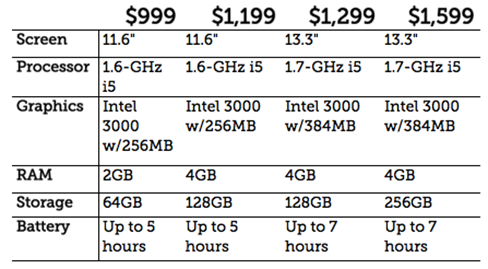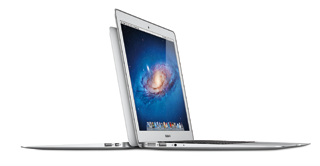Really, there are four major new features:
- The processors. The previous-generation Airs’ Core 2 Duo CPUs have given way to faster Intel i5 “Sandy Bridge” chips with Intel 3000 integrated graphics and 1333-MHz DDR3 memory. (The earlier models had NVidia’s GeForce 320M graphics and 1066-MHz DDR3 memory.) Apple, as is its wont, touts the new systems as “up to 2X faster” than the earlier ones. I didn’t do any formal benchmarking of the 13″ Air I reviewed, but it felt consistently snappy. (The Airs’ use of solid-state flash memory instead of rotating hard drives contributes hugely to their brisk feel.)
- Thunderbolt. The new Airs don’t have any additional ports, but they’re replaced the Mini DisplayPort connectors on the old models with Thunderbolt, the technology invented by Intel and championed by Apple. That’s potentially a big deal: Thunderbolt’s do-everything design is compatible with DisplayPort and Apple’s adapters for various types of monitors, but it also does USB-like data transfers, at up to 20 times the speed of USB 2. Right now, there are only a smattering of Thunderbolt products out there (Apple sells a cable for Mac-to-Mac connections, and LaCie has announced a hard drive.) But the presence of Thunderbolt ports on millions of MacBook Airs will presumably help encourage hardware manufacturers to make Thunderbolt devices.
- A backlit keyboard. The original 2008 Air had one; the 2010 versions didn’t. It’s back, and it’s awfully handy for typing in dim environments, such as red-eye flights.
- Lion. You can pay just $29.99 to put Apple’s nifty, iPad-inspired OS X upgrade on a Mac you already own, but these MacBook Airs are the first new Mac models to come with it preinstalled.
Here’s a quick guide to the standard versions of the two new Air models:

(The battery claims in the chart above are Apple’s, for Wi-Fi surfing usage. I performed no scientific battery testing, and will be interested to see what more methodical testers such as Macworld find.)
Apple also offers some build-to-order options, including an 11″ Air with 256GB of storage (up from a maximum of 128GB previously) and both the 11″ and 13″ versions with an even more potent Intel processor: the 1.8-GHz Core i7.

It doesn’t pay to fixate on the Airs’ specs, though. For one thing, like I say, their use of flash memory makes them radically zippier than they’d be if they were the same computers, but with hard disks: every time I load Photoshop and find it ready to go in about five seconds, I smile. I keep trying to stumble across a task or two that will prove that an Air is just too wimpy for some folks, but I’ve failed so far: it’s even okay for the not-terribly-sophisticated video editing I do in iMovie.
And ultimately, these computers’ defining characteristics don’t have that much to do with clockspeeds and related geekery. It’s all about what Apple built in, what it left out, and the virtues of computers that are so portable that you can forget you’ve got one tucked under your arm.
(VIDEO: The Apple iPad and You: An Odd Todd Cartoon)
The downside of flash memory, of course, is that it’s costlier and more cramped than a hard drive. Even the fully-loaded 256GB Air is a bit short on space by current standards, although I’ve found that I can live happily enough with it as long as I prune unwanted files fairly regularly and archive some stuff I rarely need to an external drive.
How about all of the features that the Air lacks?
article continues on next page…


